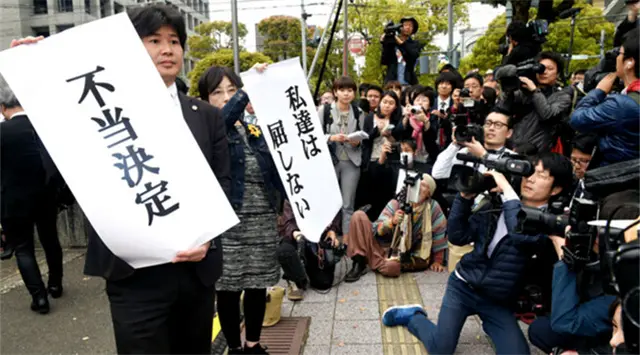Lawyers hold up signs describing the April 6 ruling by the Miyazaki branch of the Fukuoka High Court as being unjust. (Motoki Nagasawa)
A high court here rejected an appeal by Kyushu residents seeking to shut down the only two nuclear reactors operating in Japan, ruling that it is impossible to secure absolute safety with nuclear energy.
Presiding Judge Tomoichiro Nishikawa of the Miyazaki branch of the Fukuoka High Court said April 6 that current science and technology standards cannot reach a level of safety in which no radioactive materials are emitted regardless of the severity of the accident at a nuclear plant.
“A judgment has to be made based on the standard of what level of danger a society would be willing to live with,” Nishikawa said.
The court did not set any danger level, but it did rule that there was no convincing reason to issue a temporary injunction against the operations of the No. 1 and No. 2 reactors of the Sendai plant run by Kyushu Electric Power Co. in Satsuma-Sendai, Kagoshima Prefecture, in southern Japan.
The plaintiffs argued that the Nuclear Regulation Authority’s new safety standards, established after the disaster unfolded at the Fukushima No. 1 nuclear plant in 2011, underestimated possible damage to the plant caused by a powerful earthquake.
Nishikawa dismissed the argument, saying the standards “were at an extremely high level of rationality because it was needed to secure safety.”
Nishikawa, however, did describe as “irrational” the NRA’s assessment of volcanic eruption risk near the Sendai nuclear plant. That assessment was preconditioned on predicting the timing and scale of volcanic activity that would cause extensive damage to a wide area.
But the judge added that there was no basis for believing that such an eruption might occur while the plant was in operation. He concluded that “a political decision” would have to be made about whether to consider the risks related to such eruptions.
The plaintiffs, from the three Kyushu prefectures of Kagoshima, Kumamoto and Miyazaki, are considering appealing the latest ruling to the Supreme Court.
Kyushu Electric Power issued a statement on April 6 that said the ruling acknowledged the company’s past arguments that safety of the plant had been secured.
Setting a standard for an acceptable danger level could untangle the differing court decisions on the operations of nuclear reactors.
In March, for example, the Otsu District Court raised doubts about the NRA’s safety standards and ordered an injunction against two reactors at the Takahama nuclear plant in Fukui Prefecture in central Japan.
The lawsuit for an injunction against the Sendai plant was filed with the Kagoshima District Court in May 2014.
The district court rejected the plaintiffs’ request in April 2015. A few months later, in August, the No. 1 reactor at the Sendai plant became the first in Japan to resume operations under the new safety standards. The No. 2 reactor was restarted in October.
A major point of contention in the lawsuit was Kyushu Electric Power’s estimate of the largest possible quake that could hit the Sendai plant.
The plaintiffs argued that the utility’s figure, based on an average of past quakes, was defective because it underestimated the potential of possible future quakes. The residents also said their rights would be violated if a major accident occurred at the Sendai plant.
Kyushu Electric Power countered that its estimate was based on the new safety standards that reflected the latest knowledge about earthquakes.
The company said there was no specific danger of a major accident at the plant because the anti-quake measures implemented were sufficient.
The plaintiffs had also cited problems with the evacuation plans for the Sendai plant that could endanger their human rights.
But Nishikawa pointed to the approval given by the Nuclear Emergency Preparedness Commission to the evacuation plan, which was described as specific and rational because it laid out measures according to distance from the nuclear plant.
(This article was written by Yu Kamata and Morio Choh.)
(ASAHI)
 简体中文
简体中文

